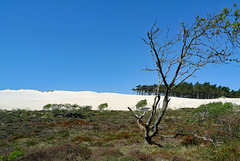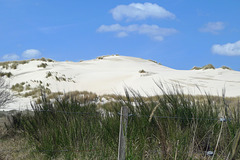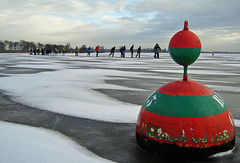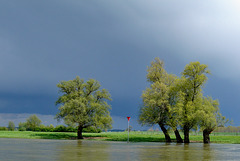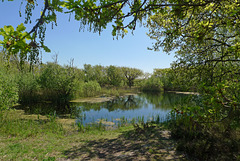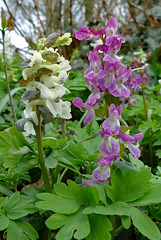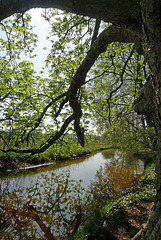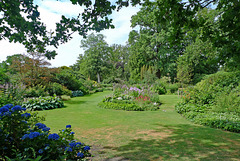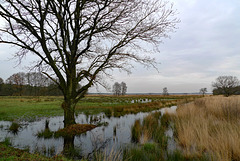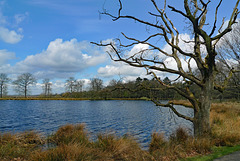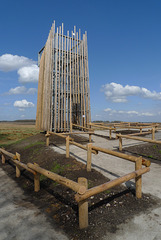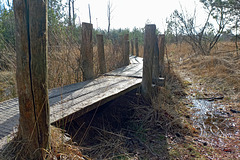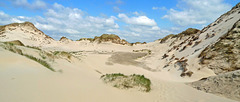
Nederland: natuur en landschap
Folder: Nederland - the Netherlands
Foto's van Nederlandse landschappen en natuur.
Voor foto's van bloembollen zie: www.ipernity.com/doc/294067/album/1303332
Nederland - Bergen aan Zee, Noordhollands Duinrese…
| |
|
|
|
The ‘Noordhollands Duinreservaat’ (North Holland Dune Reserve) is with its 5.300 hectare one of the largest natural areas in the Netherland. This reserve is managed by PWN (Water Supply Company North Holland) is used for drinking water production at three locations.
The ‘Duinreservaat’ stretches from Bergen aan Zee till Wijk aan Zee. It offers dunes, some of them with white sand (main picture and PiP1), large pine and oak forests (PiP2) and in the summer blooming heather (PiP3). The area is open to the public (walker and cyclist), however an admission ticket is needed.
Nederland - Bergen aan Zee, Noordhollands Duinrese…
| |
|
|
|
The Noordhollands Duinreservaat (North Holland Dune Reserve) is with its 5.300 hectare one of the largest natural areas in the Netherland. This reserve is managed by PWN (Water Supply Company North Holland) is used for drinking water production at three locations.
The Buizerdvlak lies north of Bergen aan Zee and is known for the impressive drifting dune that dominates the landscape. It is fascinating to see how the drifting sand slowly 'walks' to the east (between 3 and 5 meters per year) and covers all shrubs and conifers in the way under a layer of sand.
(PiP3 shows the dune almost nine years ago; it is clear to see how much the dune has moved)
Nederland - Biesbosch
| |
|
|
|
Dutch wetland ‘jungle’ in the Biesbosch* National Park. Picture was taken along the so called ‘Griendmuseumpad’. During my visit completely lined with blooming Himalayan Balsam (PiP).
The ‘Biesbosch National Park’ is a green maze of rivers, islands and a vast network of narrow and wide creeks. The park is one of largest and most valuable natural areas in the Netherlands. It’s also one of the few remaining fresh-water tidal areas in Europe.
(*Biesbosch = 'forest of sedges' or 'rushwoods')
Nederland - Blokzijl, De Wieden
| |
|
|
|
‘De Wieden’ is a large marsh wetland in the northwest of the province of Overijssel. This part of the National Park ‘Weerribben-Wieden’ is managed by the Dutch nature reserve organisation ’Natuurmonumenten’.
‘Wieden’ are man-made lakes by the excavation of peat. If one doesn't touch marsh wetland (swamp), it will gradually transform into land again. In order to maintain variety in the area’Natuurmonumenten regularly digs new holes, just like the peat diggers used to do. Nowadays ‘De Wieden’ is one of the most important lowland peat wetlands of Western Europe.
Nederland - Blokzijl, Giethoornsche Meer
| |
|
|
|
Emjoying a proper Dutch winter during the ‘Blokzijler Merentocht’, an ice skating tour of 35 km’s on the lakes in northwest Overijssel and through the nature reserve ‘De Wieden’. Due to bad ice conditions this tour (January 2009) was ‘halfway’ interrupted by officials and police.
Nederland - Brummen/Bronkhorst
| |
|
|
|
A thunderstorm above the IJssel River, nearby the ferry from Brummen to Bronkhorst (one of the smallest cities in the Netherlands).
(See for a picture and more information about Bronkhorst: www.ipernity.com/doc/294067/31724391/in/album/629489)
Nederland - Callantsoog, Zwanenwater
| |
|
|
|
The Zwanenwater (Swans Water) is a beautiful nature reserve of more than 600 ha nestled in the dunes, just south of the village of Callantsoog. The reserve was created in 1597 after the construction of the Zijperzeedijk ; dunes, valleys and lakes have been created by drifting sand. Since 1973 the area is managed by Natuurmonumenten , a society for preservation of nature monuments in the Netherlands.
Swan water' has beautiful freshwater lakes - among them the two largest natural dune lakes in Western Europe, marshes, heathland, woods, dunes, flowers and plants.
There are more than 120 endangered plant and animal species living in this area. It is an important stopping place for migratory birds and ore than 100 species of birds breed in this nature reserve. Besides birds, there are many other animals in this area such as: sand lizards, butterflies, foxes, rabbits, hedgehogs, mice, toads, cattle, frogs and water salamanders.
In all this natural beauty several species of orchids grow. They are often well hidden among the hundreds of other flowering plants.
Nederland - Camperduin
| |
|
|
|
Beach huts on the beach in Camperduin.
Beach and dunes were developed by means of sand supplementation in front of the Hondsbossche Zeewering (Hondsbossche Sea Defence) in order to increase the safety. The 5.5 kilometers long dike was expanded in the year of 2015 with a beach and dune strip with the size of more than 400 football fields.
Nederland - De Wijk, Huize Dickninge/holwortel
| |
|
|
|
Between the year of 1325 and 1652 Dickninge was a Benedictine monastery.
The monks and nuns created a garden with lots of so called ‘stinsenplanten’: called after a ‘stins’, a stone house owned by noble families. Originally the name was used in the province of Friesland, but in the meantime quite common in the whole country.
These plants were mostly blooming during springtime. The monks however were not interested in the flowers, but in the drugs they could make from the roots. One of the plants was the ‘holwortel’ (Hollowroot), or as people in De Wijk still call it ‘kloosterkruid’ (monastery herb).
The garden around Manor Dickninge - www.ipernity.com/doc/294067/40765440 - is famous for the huge number of blooming Hollowroots, which is quite rare in the Netherlands. Hollowroots and other ‘stinsenplanten’ are blooming - weather depending - between half March and half April.
Nederland - De Wijk, Reest
| |
|
|
|
The Reest is a stream that starts in the now excavated bog between Slagharen, Lutten and Dedemsvaart. De Reest is a typical lowland stream, which meanders through a flat landscape. With a height difference of only 5 meters over a distance of 37 kilometers the stream flows near Meppel into the Meppelerdiep.
The stream largely forms the border between the provinces of Overijssel and Drenthe, as a result of which the plans to channel the stream have never been carried out and the River Reest, with its many curves, slowly flows through the valley, which varies in width from 100 to 600 metres.
Nederland - Delden, Twickel Kasteel tuin en park
| |
|
|
|
Twickel Castle ( www.ipernity.com/doc/294067/48898228 ) is well-known for its garden and park. The landscaping of the gardens has been created over many generations and gives an impression of the history of the garden since the renaissance.
Next to the castle there is a garden in the French neo-baroque style (PiP1) with clipped figures of the taxus and buxus trees. The historical orangery (PiP1) dates, in its current form, to the first half of the 19th century and serves as a winter shelter for many tropical and subtropical plants, including some 300-year-old orange trees. The so called 'rock garden' (main picture and PiP2) in Victorian style has been designed by Baroness van Heeckeren Van Wassenaer.
The surrounding park, with its large water gardens (PiP3), was developed in English landscape style during the 18th and 19th century. The park has also a wildlife sanctuary (PiP4) with a pack of fallow deer.
Nederland - Delden, Kasteel Twickel, tuin en park
| |
|
|
|
Kasteel Twickel (twickel Castle) is well-known for its gardens and park. The gardens have been developed by the various generations and give a good impression of the history since the Renaissance.
The formal garden offers clipped figures of the taxus and buxus trees. The ornamental garden garden in Victorian style has been designed by the last baroness. The surrounding park - with its large water gardens - are developed in English landscape style during the 18th and 19th century. The park has also a wildlife sanctuary with a pack of fallow deer.
The orangery was built in the first half of the 19th century. It serves as a winter residence for the (sub)tropical plants, such as the 300 year old orange trees.
Nederland - Drents-Friese Wold
| |
|
|
|
The Nationaal Park Drents-Friese Wold is one of the largest areas of natural beauty in the Netherlands. The park consists of more than 6,000 hectares of forest, heathland, fens, shifting sands, pools and ponds, swamps and brook valley grasslands.
Drents-Friese Wold is located in the border region of the northern Dutch provinces of Drenthe and Friesland. During our visit we were pleasantly surprised by the varied landscape. I can not remember having seen such a diversity of landscapes in one of the twenty national parks in my country.
In the year 2000 it became a national park; in addition, the Drents-Friese Wold is one of the most beautiful and important nature areas in Europe and has therefore been designated as a “Nature2000 area”.
The park is managed by four organizations and eighty private owners.
Nederland – Dwingelderveld
| |
|
|
|
Dwingelderveld National Park is a heathland and woodland reserve of 3,700 hectares in the south-western part of the province of Drenthe in the Netherlands. It is Europe's largest wet moorland area, covered by numerous moors, idyllic fens and marsh flats featuring a wide variety of rare plants.
And wet it was during our visit !!
Nederland - Dwingelderveld
| |
|
|
|
Dwingelderveld is one of the about twenty national parks in the Netherlands and is the largest European wet heathland area. The national park - 3.700 hectares - has more than sixty fens and peat swamps featuring a rich and unique flora and fauna. The gently rolling moors and shifting sands are habitat of many kinds of species of butterflies and birds. The northern part has been wooded with pine forests and juniper shrubs since the mid 19th century. The national park is crossed by many hiking and biking trails, marked and unmarked, paved and unpaved.
Dwingelderveld is managed by the Dutch forestry Commission ( Staatsbosbeheer ) and the private Dutch society for nature conservation Natuurmonumenten . Since 1991 it is a national park and in 2013 the park was added to the List of Nature 2000, as part of the European Network of most valuable nature reserves of Europe.
Main picture and PiP’s are all taken along the so called Commissaris Cramerpad . This path - about 4 km’s long between Spier and Kraloo - was chosen in 2017 as the most beautiful bike path of the province of Drenthe. Having been there I only can agree.
See for more pictures of Dwingelderveld : www.ipernity.com/doc/294067/46540292
Nederland - Dwingelderveld
| |
|
|
|
Dwingelderveld is one of the about twenty national parks in the Netherlands and is the largest European wet heathland area. The national park - 3.700 hectares - has more than sixty shallow lakes and moors featuring a rich and unique flora and fauna. The gently rolling moors are habitat of many kinds of species of butterflies and birds. The northern part has been wooded with pine forests and juniper shrubs since the mid 19th century.
Dwingelderveld is managed the Dutch forestry Commission ( Staatsbosbeheer ) and the private Dutch society for nature conservation Natuurmonumenten .
The main picture shows the recently built lookout tower nearby the Benderse sheepfold, offering unique views over the vast heathlands (PiP) of the national park. This sheepfold houses a flock of the famous ‘Drenthe heath sheep’.
See for more pictures of Dwingelderveld : www.ipernity.com/doc/294067/46551468
Nederland - Dwingelderveld
| |
|
|
|
Nationaal Park Dwingelderveld is one of the about twenty national parks in the Netherlands and is the largest European wet heathland area. The national park - 3.700 hectares - has more than sixty fens - some of them date from the last Ice Age - and peat swamps featuring a rich and unique flora and fauna. Dwingelderveld is considered being one of the most beautiful national parks in the Netherlands.
This time we made a walk through the northern part of the Dwingelderveld . Initially through a forest that has been planted since 1925 and later along heathland and vast open swampy landscapes. What was noticeable was the very muddy state of the paths. After about four kilometers we reached the boardwalk, for which this route (marked with white arrows) is famous. This is a narrow - only three shelves wide – path, really necessary as you are walking above the water here. Although only a few hundred meters long, it was fascinating to do.
Dwingelderveld is managed by the Dutch forestry Commission ( Staatsbosbeheer ) and the private Dutch society for nature conservation Natuurmonumenten . Since 1991 it is a national park and in 2013 the park was added to the List of Nature 2000, as part of the European Network of most valuable nature reserves of Europe.
See for more pictures of Dwingelderveld : www.ipernity.com/doc/294067/46540292 and www.ipernity.com/doc/294067/46551468 .
Nederland - Egmond aan Zee, Wimmenummerduinen
| |
|
|
|
The Wimmenummerduinen (Dunes of Wimmenum) are located between the coastal villages of Egmond aan Zee and Bergen aan Zee.
The inhabitants of Egmond aan Zee - so called “derpers” (villagers) - still call the dune area Duinen van Six . In 1679, Jan Six - a regent and writer descended from a wealthy family - bought the area around the village of Wimmenum. Six belonged to the in-crowd of Amsterdam and is friends with Rembrandt van Rijn. A portrait the painter painted of him is world-famous today. The dune area was the family's fenced-off hunting domain until it was sold to the of provincial water supply company of the province of North Holland (PWN) in 1992.This company has opened the site to visitors.
The Wimmenummerduinen are characterized by an open dune landscape with several dune lakes, wet valleys and drifting dune tops. Large pieces of dune have been blown away here and there in the foredune (main picture). Horses graze the dunes here to keep the landscape open. It is considered one of the most beautiful stretches of untouched dune in the province of North Holland.
Immediately north of Egmond aan Zee are the so-called duinlandjes (dune lands) - a kind of allotment gardens. These originated around the year 1850, when villagers started growing potatoes in dune valleys. In the past, these fields also existed around other fishing villages, but nowadays they only can be found in Egmond. (PiP5).
Jump to top
RSS feed- Latest items - Subscribe to the latest items added to this album
- ipernity © 2007-2024
- Help & Contact
|
Club news
|
About ipernity
|
History |
ipernity Club & Prices |
Guide of good conduct
Donate | Group guidelines | Privacy policy | Terms of use | Statutes | In memoria -
Facebook
Twitter

